Mechanical and Corrosion Properties of Laser Surface-Treated Ti13Nb13Zr Alloy with MWCNTs Coatings
Abstract
:1. Introduction
2. Materials and Methods
2.1. Preparation of Materials
2.1.1. Preparation of Titanium Samples
2.1.2. Preparation of Suspension of Functionalized Carbon Nanotubes
2.2. Electrophoretic Deposition of Carbon Nanotube Coating
2.3. Laser Modification
2.4. Surface and Cross-Sections Evaluation of Samples
2.4.1. Preparation of Samples for Surface and Cross-Section Tests
2.4.2. Analysis of Surface Phase Composition
2.4.3. Raman Spectroscopy
2.4.4. Surface and Cross-Section Morphology and Topography and Chemical Analysis
2.4.5. Surface Wettability
2.4.6. Surface and Cross-Section Nanomechanical Properties
2.5. Corrosion Tests
2.5.1. Preparation of Samples for Corrosion Tests
2.5.2. Corrosion Measurements Using the Potentiodynamic Polarization Method
3. Results and Discussion
3.1. Measurement of MWCNTs Coating Thickness
3.2. Morphology and Topography Studies
3.3. Chemical and Phase Analysis, Raman Spectroscopy
3.4. Wettability Analysis
3.5. Nanomechanical Studies
3.6. Corrosion Tests Analysis
4. Conclusions
Author Contributions
Funding
Acknowledgments
Conflicts of Interest
References
- Suchanek, K.; Bartkowiak, A.; Gdowik, A.; Perzanowski, M.; Kąc, S.; Szaraniec, B.; Suchanek, M.; Marszałek, M. Crystalline hydroxyapatite coatings synthesized under hydrothermal conditions on modified titanium substrates. Mater. Sci. Eng. C 2015, 51, 57–63. [Google Scholar] [CrossRef]
- Souza, J.C.M.; Sordi, M.B.; Kanazawa, M.; Ravindran, S.; Henriques, B.; Silva, F.S.; Aparicio, C.; Cooper, L.F. Nano-scale modification of titanium implant surfaces to enhance osseointegration. Acta Biomater. 2019, 94, 112–131. [Google Scholar] [CrossRef] [PubMed]
- Kaur, M.; Singh, K. Review on titanium and titanium based alloys as biomaterials for orthopaedic applications. Mater. Sci. Eng. C 2019, 102, 844–862. [Google Scholar] [CrossRef] [PubMed]
- Oldani, C.; Dominguez, A. Titanium as a Biomaterial for Implants. In Recent Advances in Arthroplasty; Fokter, S., Ed.; InTech: Rijeka, Croatia, 2012; pp. 149–162. [Google Scholar]
- Granato, R.; Bonfante, E.A.; Castellano, A.; Khan, R.; Jimbo, R.; Marin, C.; Morsi, S.; Witek, L.; Coelho, P.G. Osteointegrative and microgeometric comparison between micro-blasted and alumina blasting/acid etching on grade II and V titanium alloys (Ti-6Al-4V). J. Mech. Behav. Biomed. Mater. 2019, 97, 288–295. [Google Scholar] [CrossRef] [PubMed]
- Khodaei, M.; Hossein Kelishadi, S. The effect of different oxidizing ions on hydrogen peroxide treatment of titanium dental implant. Surf. Coat. Technol. 2018, 353, 158–162. [Google Scholar] [CrossRef]
- Bartmanski, M.; Zielinski, A.; Jazdzewska, M.; Głodowska, J.; Kalka, P. Effects of electrophoretic deposition times and nanotubular oxide surfaces on properties of the nanohydroxyapatite/nanocopper coating on the Ti13Zr13Nb alloy. Ceram. Int. 2019, 45, 20002–20010. [Google Scholar] [CrossRef]
- Simka, W.; Mosiałek, M.; Nawrat, G.; Nowak, P.; Żak, J.; Szade, J.; Winiarski, A.; Maciej, A.; Szyk-Warszyńska, L. Electrochemical polishing of Ti–13Nb–13Zr alloy. Surf. Coat. Technol. 2012, 213, 239–246. [Google Scholar] [CrossRef]
- Lorenzetti, M.; Biglino, D.; Novak, S.; Kobe, S. Photoinduced properties of nanocrystalline TiO2-anatase coating on Ti-based bone implants. Mater. Sci. Eng. C 2014, 37, 390–398. [Google Scholar] [CrossRef]
- Lorenzetti, M.; Pellicer, E.; Sort, J.; Baró, M.; Kovač, J.; Novak, S.; Kobe, S. Improvement to the Corrosion Resistance of Ti-Based Implants Using Hydrothermally Synthesized Nanostructured Anatase Coatings. Materials 2014, 7, 180–194. [Google Scholar] [CrossRef] [Green Version]
- Kazek-Kęsik, A.; Leśniak, K.; Zhidkov, I.; Korotin, D.; Kukharenko, A.; Cholakh, S.; Kalemba-Rec, I.; Suchanek, K.; Kurmaev, E.; Simka, W. Influence of Alkali Treatment on Anodized Titanium Alloys in Wollastonite Suspension. Metals 2017, 7, 322. [Google Scholar] [CrossRef] [Green Version]
- Ossowska, A.; Sobieszczyk, S.; Supernak, M.; Zielinski, A. Morphology and properties of nanotubular oxide layer on the “Ti–13Zr–13Nb” alloy. Surf. Coat. Technol. 2014, 258, 1239–1248. [Google Scholar] [CrossRef]
- Lin, Z.; Li, S.-J.; Sun, F.; Ba, D.-C.; Li, X.-C. Surface characteristics of a dental implant modified by low energy oxygen ion implantation. Surf. Coat. Technol. 2019, 365, 208–213. [Google Scholar] [CrossRef]
- Acciari, H.A.; Palma, D.P.S.; Codaro, E.N.; Zhou, Q.; Wang, J.; Ling, Y.; Zhang, J.; Zhang, Z. Surface modifications by both anodic oxidation and ion beam implantation on electropolished titanium substrates. Appl. Surf. Sci. 2019, 487, 1111–1120. [Google Scholar] [CrossRef]
- Gao, C.; Dai, L.; Meng, W.; He, Z.; Wang, L. Electrochemically promoted electroless nickel-phosphorous plating on titanium substrate. Appl. Surf. Sci. 2017, 392, 912–919. [Google Scholar] [CrossRef]
- Wang, Y.; Gao, Y.; Takahashi, J.; Wan, Y.; Xiao, B.; Zhang, Y.; He, X.; Li, J. Titanium-modified graphite reinforced Cu-Ni composite by multi-arc ion plating technology. Vacuum 2019, 168, 108829. [Google Scholar] [CrossRef]
- Zong, X.; Wang, H.; Li, Z.; Li, J.; Cheng, X.; Zhu, Y.; Tian, X.; Tang, H. Laser nitridation on Ti-6.5Al-3.5Mo-1.5Zr-0.3Si titanium alloy. Surf. Coat. Technol. 2020, 386, 125425. [Google Scholar] [CrossRef]
- Zhu, W.; Shi, D.; Zhu, Z.; Sun, J. Effect of the surface oxidization and nitridation on the normal spectral emissivity of titanium alloys Ti–6Al–4V at 800–1100 K at a wavelength of 1.5 μm. Infrared Phys. Technol. 2016, 76, 200–205. [Google Scholar] [CrossRef]
- Buga, C.; Hunyadi, M.; Gácsi, Z.; Hegedűs, C.; Hakl, J.; Schmidt, U.; Ding, S.-J.; Csík, A. Calcium silicate layer on titanium fabricated by electrospray deposition. Mater. Sci. Eng. C 2019, 98, 401–408. [Google Scholar] [CrossRef]
- Avcu, E.; Baştan, F.E.; Abdullah, H.Z.; Rehman, M.A.U.; Avcu, Y.Y.; Boccaccini, A.R. Electrophoretic deposition of chitosan-based composite coatings for biomedical applications: A review. Prog. Mater. Sci. 2019, 103, 69–108. [Google Scholar] [CrossRef]
- Gilabert-Chirivella, E.; Pérez-Feito, R.; Ribeiro, C.; Ribeiro, S.; Correia, D.M.; González-Martín, M.L.; Manero, J.M.; Lanceros-Méndez, S.; Ferrer, G.G.; Gómez-Ribelles, J.L. Chitosan patterning on titanium implants. Prog. Org. Coat. 2017, 111, 23–28. [Google Scholar] [CrossRef]
- Suchanek, K.; Hajdyła, M.; Maximenko, A.; Zarzycki, A.; Marszałek, M.; Jany, B.R.; Krok, F. The influence of nanoporous anodic titanium oxide substrates on the growth of the crystalline hydroxyapatite coatings. Mater. Chem. Phys. 2017, 186, 167–178. [Google Scholar] [CrossRef]
- Jażdżewska, M.; Majkowska-Marzec, B. Hydroxyapatite deposition on the laser modified Ti13Nb13Zr alloy. Adv. Mater. Sci. 2017, 17, 5–13. [Google Scholar] [CrossRef] [Green Version]
- Chozhanathmisra, M.; Murugan, N.; Karthikeyan, P.; Sathishkumar, S.; Anbarasu, G.; Rajavel, R. Development of antibacterial activity and corrosion resistance properties of electrodeposition of mineralized hydroxyapatite coated on titanium alloy for biomedical applications. Mater. Today Proc. 2017, 4, 12393–12400. [Google Scholar] [CrossRef]
- Saphronov, V.; Shishkovsky, I. Laser Annealing for Gas-Dynamical Spraying of HA Coating upon a Titanium Surface. Crystals 2015, 5, 447–457. [Google Scholar] [CrossRef] [Green Version]
- Bartmanski, M.; Cieslik, B.; Glodowska, J.; Kalka, P.; Pawlowski, L.; Pieper, M.; Zielinski, A. Electrophoretic deposition (EPD) of nanohydroxyapatite—Nanosilver coatings on Ti13Zr13Nb alloy. Ceram. Int. 2017, 43, 11820–11829. [Google Scholar] [CrossRef]
- Bartmanski, M.; Zielinski, A.; Majkowska-Marzec, B.; Strugala, G. Effects of solution composition and electrophoretic deposition voltage on various properties of nanohydroxyapatite coatings on the Ti13Zr13Nb alloy. Ceram. Int. 2018, 44, 19236–19246. [Google Scholar] [CrossRef]
- Bartmański, M.; Pawłowski, Ł.; Strugała, G.; Mielewczyk-Gryń, A.; Zieliński, A. Properties of Nanohydroxyapatite Coatings Doped with Nanocopper, Obtained by Electrophoretic Deposition on Ti13Zr13Nb Alloy. Materials 2019, 12, 3741. [Google Scholar] [CrossRef] [Green Version]
- Bose, S.; Vu, A.A.; Emshadi, K.; Bandyopadhyay, A. Effects of polycaprolactone on alendronate drug release from Mg-doped hydroxyapatite coating on titanium. Mater. Sci. Eng. C 2018, 88, 166–171. [Google Scholar] [CrossRef]
- Ciobanu, G.; Harja, M. Cerium-doped hydroxyapatite/collagen coatings on titanium for bone implants. Ceram. Int. 2019, 45, 2852–2857. [Google Scholar] [CrossRef]
- Długoń, E.; Niemiec, W.; Frączek-Szczypta, A.; Jeleń, P.; Sitarz, M.; Błażewicz, M. Spectroscopic studies of electrophoretically deposited hybrid HAp/CNT coatings on titanium. Spectrochim. Acta. A. Mol. Biomol. Spectrosc. 2014, 133, 872–875. [Google Scholar] [CrossRef]
- Zhong, Z.; Qin, J.; Ma, J. Electrophoretic deposition of biomimetic zinc substituted hydroxyapatite coatings with chitosan and carbon nanotubes on titanium. Ceram. Int. 2015, 41, 8878–8884. [Google Scholar] [CrossRef]
- Dziaduszewska, M.; Wekwejt, M.; Bartmański, M.; Pałubicka, A.; Gajowiec, G.; Seramak, T.; Osyczka, A.M.; Zieliński, A. The Effect of Surface Modification of Ti13Zr13Nb Alloy on Adhesion of Antibiotic and Nanosilver-Loaded Bone Cement Coatings Dedicated for Application as Spacers. Materials 2019, 12, 2964. [Google Scholar] [CrossRef] [PubMed] [Green Version]
- Grabarczyk, J.; Batory, D.; Louda, P.; Couvrat, P.; Kotela, I.; Bakowicz-Mitura, K. Carbon coatings for medical implants. J. Achiev. Mater. Manuf. Eng. 2007, 20, 107–110. [Google Scholar]
- Madej, M.; Piotrowska, K.; Ozimina, D. Properties of diamond-like carbon coatings on the titanium alloy Ti13Nb13Zr. Bimon. Tribol. 2019, 6, 39–46. [Google Scholar] [CrossRef]
- Chen, X.; Chen, S.; Liang, L.; Hong, H.; Zhang, Z.; Shen, B. Electrochemical behaviour of EPD synthesized graphene coating on titanium alloys for orthopedic implant application. Procedia CIRP 2018, 71, 322–328. [Google Scholar] [CrossRef]
- Chen, C.; Tang, W.; Li, X.; Wang, W.; Xu, C. Structure and cutting performance of Ti-DLC films prepared by reactive magnetron sputtering. Diam. Relat. Mater. 2020, 104, 107735. [Google Scholar] [CrossRef]
- Strąkowska, P.; Beutner, R.; Gnyba, M.; Zielinski, A.; Scharnweber, D. Electrochemically assisted deposition of hydroxyapatite on Ti6Al4V substrates covered by CVD diamond films—Coating characterization and first cell biological results. Mater. Sci. Eng. C 2016, 59, 624–635. [Google Scholar] [CrossRef]
- Ding, H.H.; Fridrici, V.; Guillonneau, G.; Sao-Joao, S.; Geringer, J.; Fontaine, J.; Kapsa, P. Investigation on mechanical properties of tribofilm formed on Ti–6Al–4V surface sliding against a DLC coating by nano-indentation and micro-pillar compression techniques. Wear 2019, 432–433, 202954. [Google Scholar] [CrossRef]
- Jędrzejczak, A.; Batory, D. Powłoki węglowe domieszkowane krzemem wytwarzane metodą RF PACVD. Inż. Mater. 2013, 34, 459–462. [Google Scholar]
- Wang, J.; Ma, J.; Huang, W.; Wang, L.; He, H.; Liu, C. The investigation of the structures and tribological properties of F-DLC coatings deposited on Ti-6Al-4V alloys. Surf. Coat. Technol. 2017, 316, 22–29. [Google Scholar] [CrossRef]
- Chou, C.-C.; Lin, J.-S.; Wu, R. Microstructures and mechanical properties of an a-C:N film as the interlayer and the outmost layer of a DLC-deposited Ti bio-alloy. Ceram. Int. 2017, 43, S776–S783. [Google Scholar] [CrossRef]
- Bhui, A.S.; Bains, P.S.; Sidhu, S.S.; Singh, G. Parametric optimization of ED machining of Ti-6Al-4V in CNTs mixed dielectric medium. Mater. Today Proc. 2019, 18, 1532–1539. [Google Scholar] [CrossRef]
- Rogala-Wielgus, D.; Majkowska-Marzec, B. Wpływ stopowania laserowego z użyciem nanorurek węglowych stopu Ti13Nb13Zr do zastosowań biomedycznych na jego wybrane własności mechaniczne. Przegląd Spaw. Weld. Technol. Rev. 2018, 90, 18–23. [Google Scholar] [CrossRef]
- Ba, J.; Zheng, X.H.; Ning, R.; Lin, J.H.; Qi, J.L.; Cao, J.; Cai, W.; Feng, J.C. Brazing of SiO 2-BN modified with in situ synthesized CNTs to Ti6Al4V alloy by TiZrNiCu brazing alloy. Ceram. Int. 2018, 44, 10210–10214. [Google Scholar] [CrossRef]
- Majkowska-Marzec, B.; Rogala-Wielgus, D.; Bartmański, M.; Bartosewicz, B.; Zieliński, A. Comparison of Properties of the Hybrid and Bilayer MWCNTs—Hydroxyapatite Coatings on Ti Alloy. Coatings 2019, 9, 643. [Google Scholar] [CrossRef] [Green Version]
- Munir, K.S.; Zheng, Y.; Zhang, D.; Lin, J.; Li, Y.; Wen, C. Microstructure and mechanical properties of carbon nanotubes reinforced titanium matrix composites fabricated via spark plasma sintering. Mater. Sci. Eng. A 2017, 688, 505–523. [Google Scholar] [CrossRef]
- Okoro, A.M.; Machaka, R.; Lephuthing, S.S.; Oke, S.R.; Awotunde, M.A.; Olubambi, P.A. Evaluation of the sinterability, densification behaviour and microhardness of spark plasma sintered multiwall carbon nanotubes reinforced Ti6Al4V nanocomposites. Ceram. Int. 2019, 45, 19864–19878. [Google Scholar] [CrossRef]
- Savalani, M.M.; Ng, C.C.; Li, Q.H.; Man, H.C. In situ formation of titanium carbide using titanium and carbon-nanotube powders by laser cladding. Appl. Surf. Sci. 2012, 258, 3173–3177. [Google Scholar] [CrossRef]
- Wesełucha-Birczyńska, A.; Stodolak-Zych, E.; Piś, W.; Długoń, E.; Benko, A.; Błażewicz, M. A model of adsorption of albumin on the implant surface titanium and titanium modified carbon coatings (MWCNT-EPD). 2D correlation analysis. J. Mol. Struct. 2016, 1124, 61–70. [Google Scholar] [CrossRef]
- Lisiecki, A. Study of Optical Properties of Surface Layers Produced by Laser Surface Melting and Laser Surface Nitriding of Titanium Alloy. Materials 2019, 12, 3112. [Google Scholar] [CrossRef] [Green Version]
- Tęczar, P.; Majkowska-Marzec, B.; Bartmański, M. The Influence of Laser Alloying of Ti13Nb13Zr on Surface Topography and Properties. Adv. Mater. Sci. 2019, 19, 44–56. [Google Scholar] [CrossRef] [Green Version]
- Xie, Z.; Dai, Y.; Ou, X.; Ni, S.; Song, M. Effects of selective laser melting build orientations on the microstructure and tensile performance of Ti–6Al–4V alloy. Mater. Sci. Eng. A 2020, 776, 139001. [Google Scholar] [CrossRef]
- Yamaguchi, T.; Hagino, H. Formation of titanium carbide layer by laser alloying with a light-transmitting resin. Opt. Lasers Eng. 2017, 88, 13–19. [Google Scholar] [CrossRef]
- Dolgun, E.; Zemlyakov, E.; Shalnova, S.; Gushchina, M.; Promahov, V. The influence of heat treatment on the microstructure of products manufactured by direct laser deposition using titanium alloy Ti-6Al-4V. Mater. Today Proc. 2020. [Google Scholar] [CrossRef]
- Kosec, T.; Legat, A.; Kovač, J.; Klobčar, D. Influence of Laser Colour Marking on the Corrosion Properties of Low Alloyed Ti. Coatings 2019, 9, 375. [Google Scholar] [CrossRef] [Green Version]
- Pou, P.; Riveiro, A.; del Val, J.; Comesaña, R.; Penide, J.; Arias-González, F.; Soto, R.; Lusquiños, F.; Pou, J. Laser surface texturing of Titanium for bioengineering applications. Procedia Manuf. 2017, 13, 694–701. [Google Scholar] [CrossRef]
- Feizi Mohazzab, B.; Jaleh, B.; Kakuee, O.; Fattah-alhosseini, A. Formation of titanium carbide on the titanium surface using laser ablation in n-heptane and investigating its corrosion resistance. Appl. Surf. Sci. 2019, 478, 623–635. [Google Scholar] [CrossRef]
- Landowski, M. Influence of Parameters of Laser Beam Welding on Structure of 2205 Duplex Stainless Steel. Adv. Mater. Sci. 2019, 19, 21–31. [Google Scholar] [CrossRef] [Green Version]
- Kusinski, J.; Kac, S.; Kopia, A.; Radziszewska, A.; Rozmus-Górnikowska, M.; Major, B.; Major, L.; Marczak, J.; Lisiecki, A. Laser modification of the materials surface layer—A review paper. Bull. Pol. Acad. Sci. Tech. Sci. 2012, 60, 711–728. [Google Scholar] [CrossRef]
- Adesina, O.; Popoola, P.A.I.; Fatoba, O.S. Laser Surface Modification—A Focus on the Wear Degradation of Titanium Alloy. In Fiber Laser; Paul, M.C., Ed.; InTech: Rijeka, Croatia, 2016; pp. 367–381. [Google Scholar]
- Jażdżewska, M. Effects of Co2 and Nd:YAG Laser Remelting of the Ti6Al4V Alloy on the Surface Quality and Residual Stresses. Adv. Mater. Sci. 2020, 20, 82–90. [Google Scholar] [CrossRef]
- Fraczek-Szczypta, A.; Dlugon, E.; Weselucha-Birczynska, A.; Nocun, M.; Blazewicz, M. Multi walled carbon nanotubes deposited on metal substrate using EPD technique. A spectroscopic study. J. Mol. Struct. 2013, 1040, 238–245. [Google Scholar] [CrossRef]
- Oliver, W.C.; Pharr, G.M. An improved technique for determining hardness and elastic modulus using load and displacement sensing indentation experiments. J. Mater. Res. 1992, 7, 1564–1583. [Google Scholar] [CrossRef]
- Łatka, L.; Cattini, A.; Chicot, D.; Pawlowski, L.; Stefan, K.; Petit, F.; Denoirjean, A. Mechanical Properties of Yttria-and Ceria- Stabilized Zirconia Coatings Obtained by Suspension Plasma Spraying. J. Therm. Spray Technol. 2013, 22, 125–130. [Google Scholar] [CrossRef]
- Oliver, W.C.; Pharr, G.M. Measurement of hardness and elastic modulus by instrumented indentation: Advances in understanding and refinements to methodology. J. Mater. Res. 2004, 19, 3–20. [Google Scholar] [CrossRef]
- Hamedi, M.J.; Torkamany, M.J.; Sabbaghzadeh, J. Effect of pulsed laser parameters on in-situ TiC synthesis in laser surface treatment. Opt. Lasers Eng. 2011, 49, 557–563. [Google Scholar] [CrossRef]
- Seo, D.M.; Hwang, T.W.; Moon, Y.H. Carbonitriding of Ti-6Al-4V alloy via laser irradiation of pure graphite powder in nitrogen environment. Surf. Coat. Technol. 2019, 363, 244–254. [Google Scholar] [CrossRef]
- Courant, B.; Hantzpergue, J.-J.; Benayoun, S.; L’Huillier, J.-P. Melting and solidification processes in a moving graphite-covered titanium surface subjected to multi-pulse laser irradiation. J. Phys. Appl. Phys. 2001, 34, 1437–1446. [Google Scholar] [CrossRef]
- ASM International. ASM Handbook, 10th ed.; ASM International: Materials Park, OH, USA, 1990; Volume 3. [Google Scholar]
- Dobrzańska-Danikiewicz, A.D.; Łukowiec, D.; Cichocki, D.; Wolany, W. Carbon nanotubes manufacturing using the CVD equipment against the background of other methods. Arch. Mater. Sci. Eng. 2013, 64, 103–109. [Google Scholar]
- Lohse, B.H.; Calka, A.; Wexler, D. Raman spectroscopy as a tool to study TiC formation during controlled ball milling. J. Appl. Phys. 2005, 97, 114912. [Google Scholar] [CrossRef] [Green Version]
- Su, Y.; Luo, C.; Zhang, Z.; Hermawan, H.; Zhu, D.; Huang, J.; Liang, Y.; Li, G.; Ren, L. Bioinspired surface functionalization of metallic biomaterials. J. Mech. Behav. Biomed. Mater. 2018, 77, 90–105. [Google Scholar] [CrossRef]
- Khandan, A.; Abdellahi, M.; Ozada, N.; Ghayour, H. Study of the bioactivity, wettability and hardness behaviour of the bovine hydroxyapatite-diopside bio-nanocomposite coating. J. Taiwan Inst. Chem. Eng. 2016, 60, 538–546. [Google Scholar] [CrossRef]
- Menzies, K.L.; Jones, L. The Impact of Contact Angle on the Biocompatibility of Biomaterials. Optom. Vis. Sci. 2010, 87, 387–399. [Google Scholar] [CrossRef] [PubMed]
- Lee, J.H.; Khang, G.; Lee, J.W.; Lee, H.B. Interaction of Different Types of Cells on Polymer Surfaces with Wettability Gradient. J. Colloid Interface Sci. 1998, 205, 323–330. [Google Scholar] [CrossRef] [PubMed]
- Heise, S.; Forster, C.; Heer, S.; Qi, H.; Zhou, J.; Virtanen, S.; Lu, T.; Boccaccini, A.R. Electrophoretic deposition of gelatine nanoparticle/chitosan coatings. Electrochim. Acta 2019, 307, 318–325. [Google Scholar] [CrossRef]
- Cordero-Arias, L.; Cabanas-Polo, S.; Gao, H.; Gilabert, J.; Sanchez, E.; Roether, J.A.; Schubert, D.W.; Virtanen, S.; Boccaccini, A.R. Electrophoretic deposition of nanostructured-TiO2/chitosan composite coatings on stainless steel. RSC Adv. 2013, 3, 11247. [Google Scholar] [CrossRef] [Green Version]

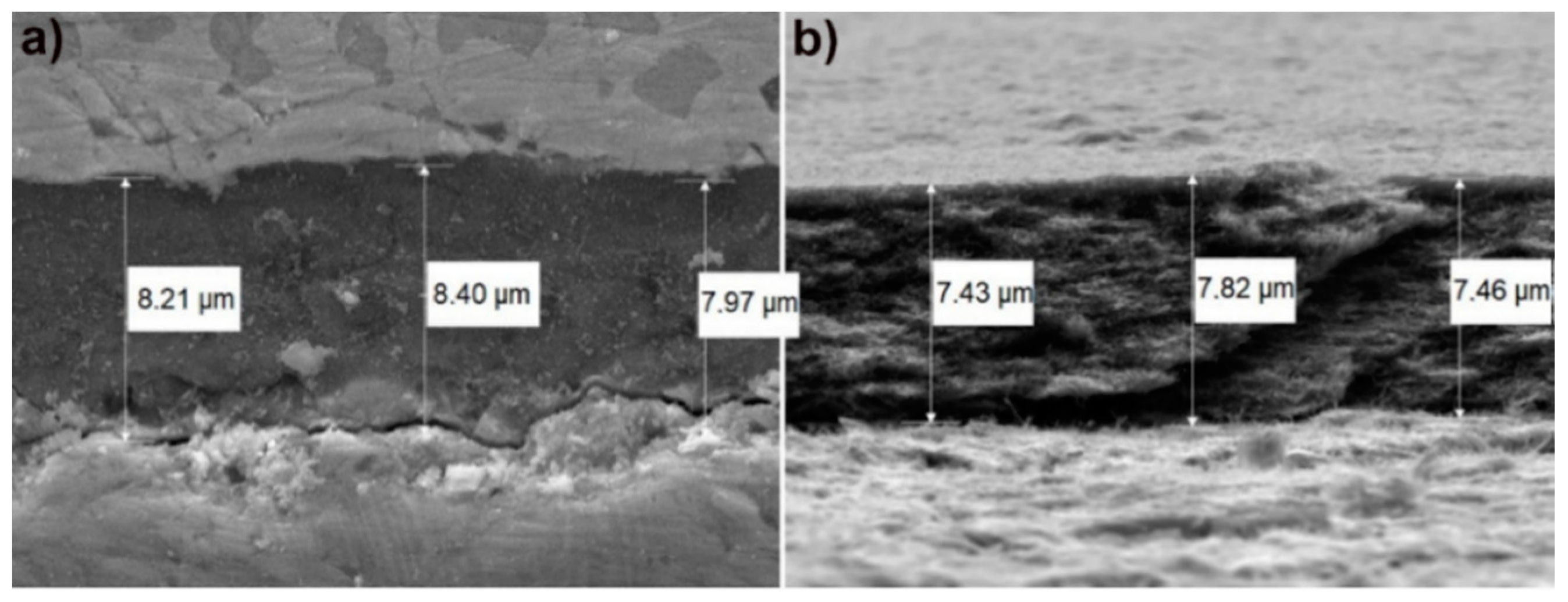
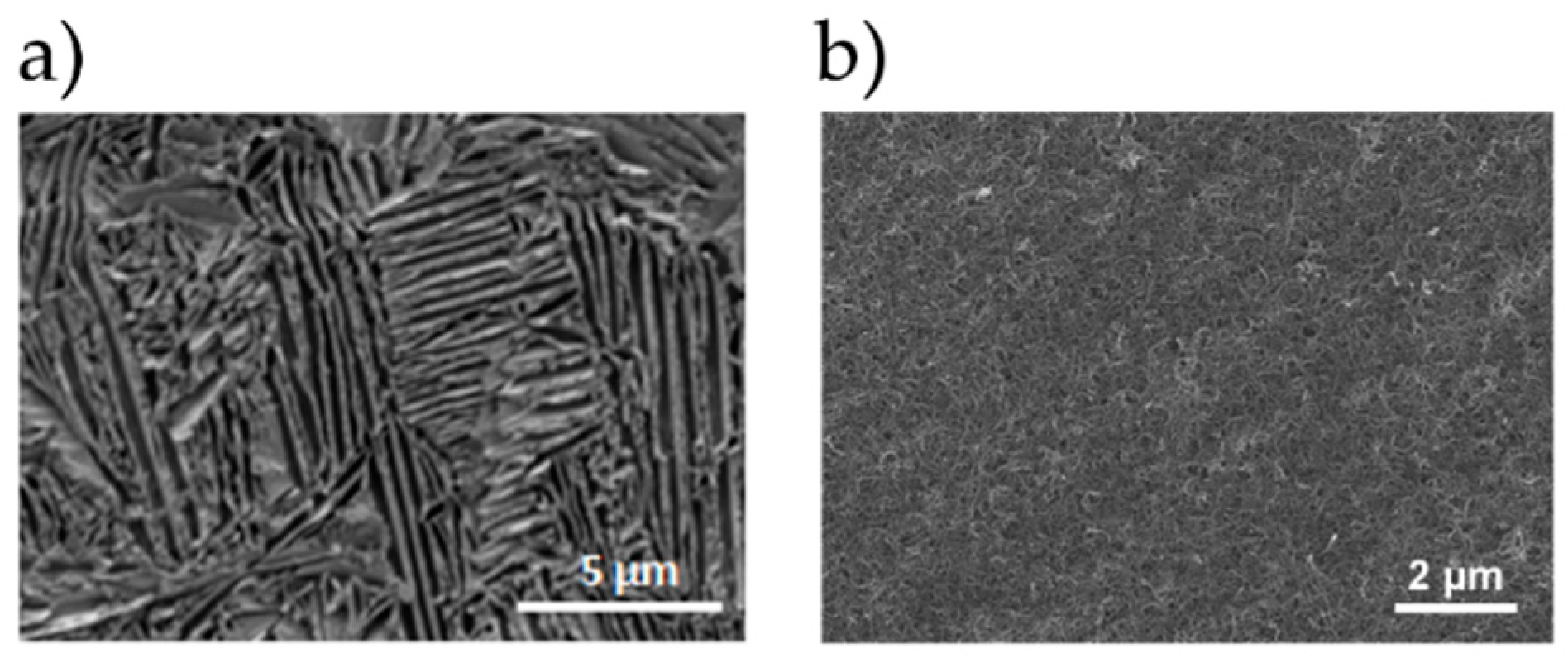

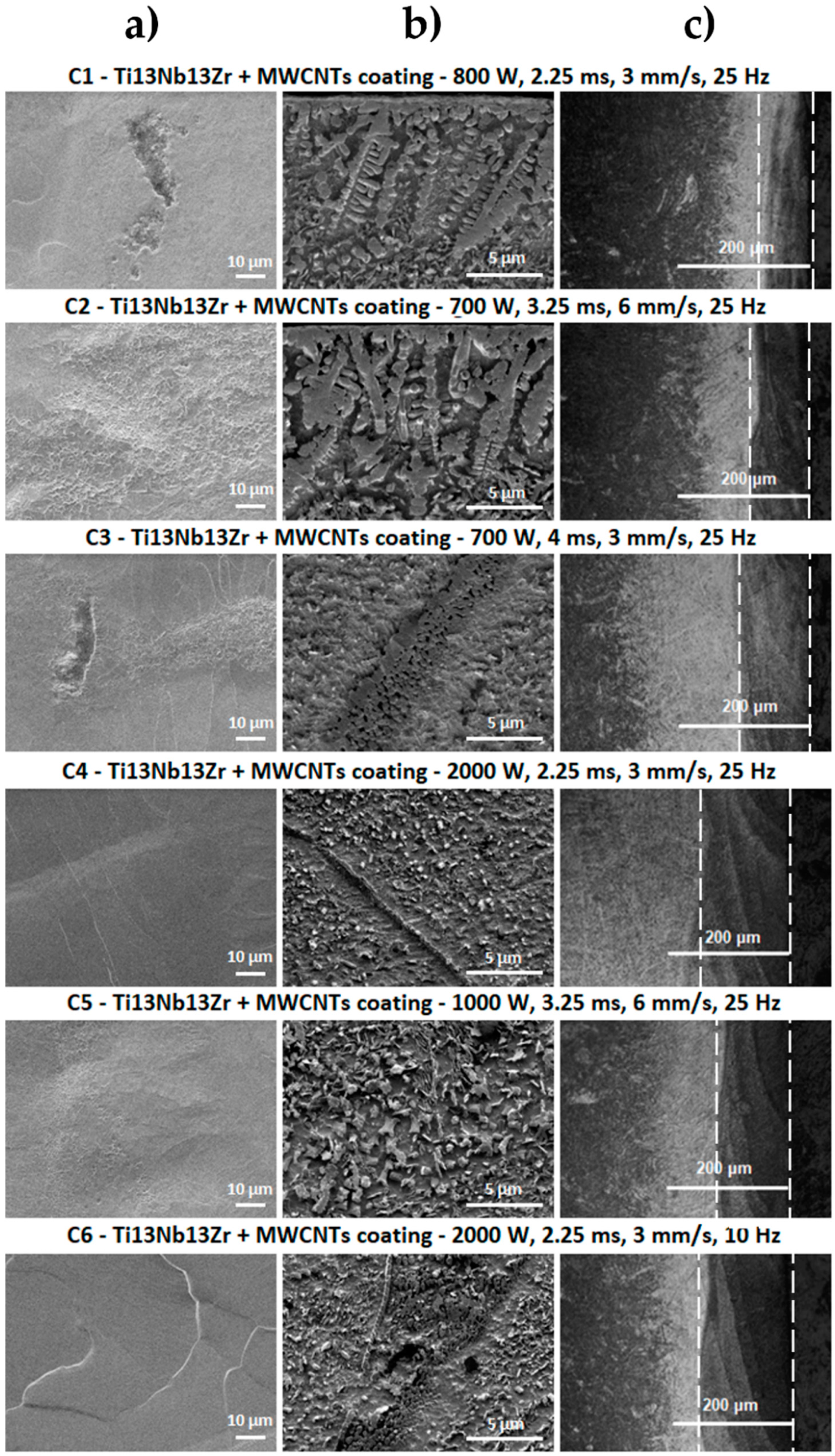




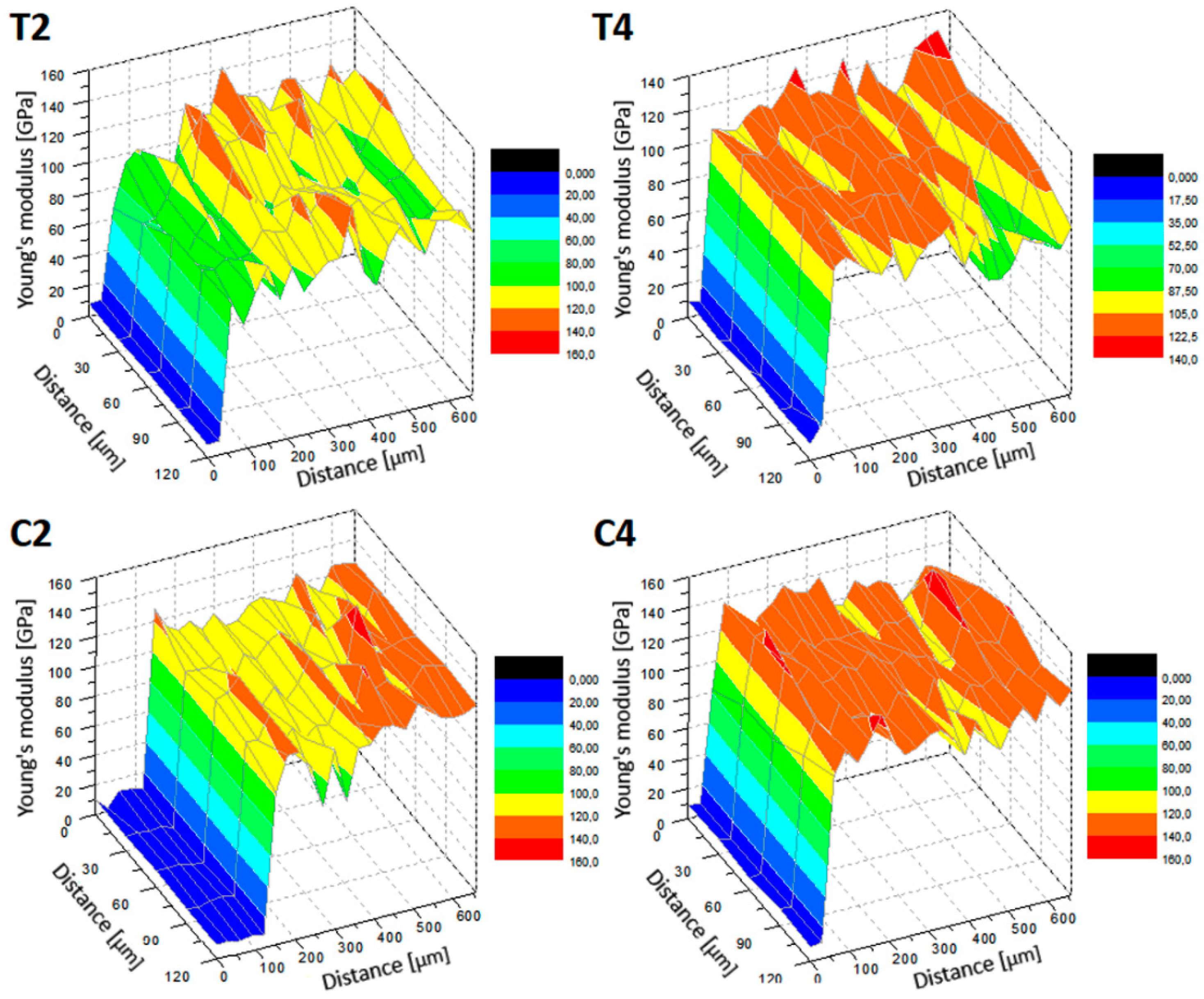
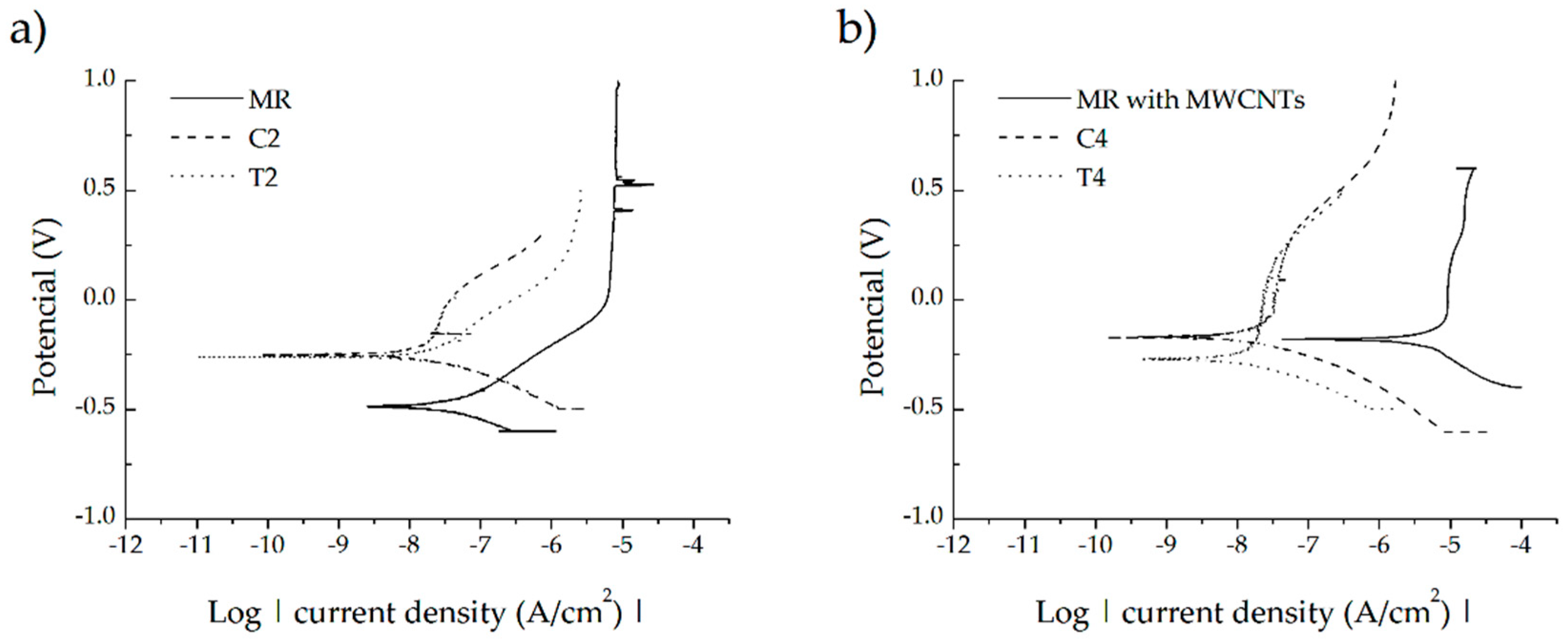
| Chemical Element | C | Fe | N | O | Zr | Nb | Ti |
|---|---|---|---|---|---|---|---|
| Alloy | Chemical Composition (% wt.) | ||||||
| Ti13Nb13Zr | 0.04 | 0.05 | 0.019 | 0.11 | 13.0 | 13.0 | 72.78 |
| Sample | Material | Power of the Laser Pulse (W) | Duration of the Laser Pulse (ms) | Feed Speed (mm/s) | Frequency (Hz) |
|---|---|---|---|---|---|
| T1, C1 | T-Ti13Nb13Zr alloy, C-Ti13Nb13Zr alloy with MWCNTs coating | 800 | 2.25 | 3.00 | 25 |
| T2, C2 | 700 | 3.25 | 6.00 | 25 | |
| T3, C3 | 700 | 4.00 | 3.00 | 25 | |
| T4, C4 | 2000 | 2.25 | 3.00 | 25 | |
| T5, C5 | 1000 | 3.25 | 6.00 | 25 | |
| T6, C6 | 2000 | 2.25 | 3.00 | 10 |
| Sample | Average Contact Angle (°) |
|---|---|
| MR | 47.1 ± 1.1 |
| T2 | 81.6 ± 0.9 |
| T4 | 77.0 ± 0.8 |
| C2 | 77.0 ± 1.1 |
| C4 | 46.1 ± 3.6 |
| Area | Sample | Nanohardness (GPa) | Reduced Young’s Modulus, Er (GPa) | Real Young’s Modulus, E (GPa) | Maximum Depth of Indentation (nm) | ||||
|---|---|---|---|---|---|---|---|---|---|
| Laser-melted layer | T2 | 4.08 | +0.72 −0.91 | 90.61 | +10.58 −18.86 | 85.72 | +10.88 −19.10 | 796.00 | +31.12 −52.95 |
| T4 | 4.98 | +1.03 −1.65 | 111.05 | +13.52 −17.22 | 107.07 | +14.57 −17.22 | 722.55 | +154.92 −164.58 | |
| C2 | 5.83 | +2.25 −1.96 | 115.11 | +13.23 −16.43 | 111.42 | +14.37 −17.44 | 678.90 | +138.87 −97.02 | |
| C4 | 6.36 | +2.37 −1.78 | 126.12 | +25.09 −29.67 | 123.51 | +28.09 −42.12 | 647.94 | +128.02 −81.38 | |
| Layer affected by the heat of the laser beam | T2 | 3.92 | +0.82 −0.57 | 104.96 | +13.74 −9.14 | 100.62 | +14.64 −9.61 | 812.05 | +57.46 −78.07 |
| T4 | 3.79 | +2.34 −1.46 | 116.21 | +41.58 −26.49 | 112.75 | +46.50 −28.03 | 816.70 | +216.97 −237.58 | |
| C2 | 4.51 | +1.13 −1.53 | 109.33 | +14.80 −20.16 | 105.28 | +15.87 −21.13 | 765.10 | +159.98 −87.53 | |
| C4 | 5.80 | +0.95 −1.20 | 127.76 | +11.83 −13.66 | 125.19 | +13.15 −14.91 | 667.52 | +79.28 −48.62 | |
| Material that was not affected by the laser | T2 | 3.27 | +1.26 −1.30 | 113.70 | +29.82 −25.35 | 110.02 | +32.77 −26.99 | 879.79 | +238.07 −226.77 |
| T4 | 2.92 | +1.57 −1.22 | 105.83 | +26.35 −25.10 | 101.70 | +28.35 −26.10 | 947.87 | +259.87 −204.44 | |
| C2 | 4.31 | +2.02 −1.10 | 124.80 | +29.48 −15.21 | 121.97 | +33.20 −16.50 | 765.42 | +111.24 −137.40 | |
| C4 | 5.70 | +1.86 −1.17 | 128.83 | +23.80 −17.39 | 126.41 | +28.84 −18.97 | 674.64 | +79.26 −91.28 | |
| Sample | Corrosion Parameters | |
|---|---|---|
| Ecorr (V) | Icorr (A/cm2) | |
| MR | −4.87 × 10−1 | 5.19 × 10−8 |
| MR with MWCNTs coating | −1.80 × 10−1 | 3.52 × 10−6 |
| T2 | −2.55 × 10−1 | 3.47 × 10−8 |
| T4 | −2.69 × 10−1 | 2.33 × 10−8 |
| C2 | −2.45 × 10−1 | 3.10 × 10−8 |
| C4 | −1.63 × 10−1 | 4.22 × 10−8 |
© 2020 by the authors. Licensee MDPI, Basel, Switzerland. This article is an open access article distributed under the terms and conditions of the Creative Commons Attribution (CC BY) license (http://creativecommons.org/licenses/by/4.0/).
Share and Cite
Majkowska-Marzec, B.; Tęczar, P.; Bartmański, M.; Bartosewicz, B.; Jankiewicz, B.J. Mechanical and Corrosion Properties of Laser Surface-Treated Ti13Nb13Zr Alloy with MWCNTs Coatings. Materials 2020, 13, 3991. https://doi.org/10.3390/ma13183991
Majkowska-Marzec B, Tęczar P, Bartmański M, Bartosewicz B, Jankiewicz BJ. Mechanical and Corrosion Properties of Laser Surface-Treated Ti13Nb13Zr Alloy with MWCNTs Coatings. Materials. 2020; 13(18):3991. https://doi.org/10.3390/ma13183991
Chicago/Turabian StyleMajkowska-Marzec, Beata, Patryk Tęczar, Michał Bartmański, Bartosz Bartosewicz, and Bartłomiej J. Jankiewicz. 2020. "Mechanical and Corrosion Properties of Laser Surface-Treated Ti13Nb13Zr Alloy with MWCNTs Coatings" Materials 13, no. 18: 3991. https://doi.org/10.3390/ma13183991





